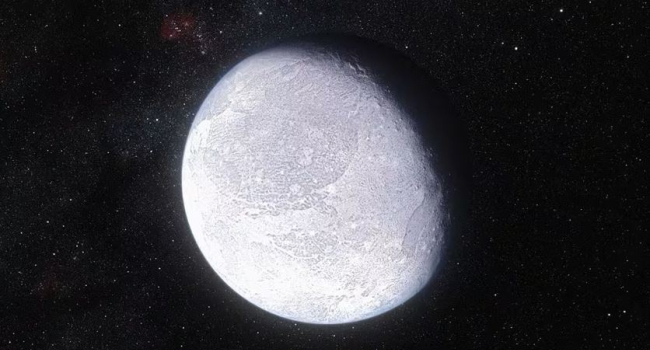
New discovery: 2 dwarf planets in the solar system may have underground oceans
Two dwarf planets in our solar system, namely Eris and Makemake, may demonstrate sufficient geothermal activity to sustain liquid water oceans, according to models describing recent observations made with the James Webb Space Telescope.
"We observe intriguing indications of warmth in cooler regions," stated Christopher Glein, a planetary geochemist from Texas' Southwest Research Institute.
Situated deep in the Kuiper Belt, Eris is the icy celestial body that, upon its discovery in January 2005, triggered a reevaluation of Pluto's status in the solar system. Though only 44 kilometers (27 miles) smaller than Pluto, Eris is 25% more massive due to a higher concentration of rock in its core, establishing Eris as the prototype dwarf planet. Subsequently, Pluto was compelled to assume a similar designation. Makemake (pronounced "Mah-kay-Mah-kay") was identified two months after Eris, measuring approximately 1430 km (888 miles) across and about 1000 km (600 miles) smaller than both Eris and Pluto.
Their considerable distance from the Sun—Eris is presently 14.4 billion kilometers (8.9 billion miles) away, while Makemake is 7.7 billion kilometers (4.8 billion miles) away—has resulted in limited knowledge about these distant dwarf planets. However, recent James Webb Space Telescope observations have provided new insights into these worlds, revealing an unexpected source for the frozen methane ice on their surfaces.
What has the James Webb data revealed?
"We discovered evidence suggesting thermal processes generating methane from within Eris and Makemake," explained Glein.
Methane, classified as a hydrocarbon, is formed from a combination of hydrogen and carbon atoms (specifically, one carbon atom and four hydrogen atoms). These atoms can exist in different isotopic forms, containing the same number of protons but varying numbers of neutrons.
If the methane on the surfaces of these dwarf planets had originated from the primordial planet-forming disk around the young sun 4.5 billion years ago, it would exhibit a specific isotopic ratio between two hydrogen isotopes—regular hydrogen (one proton, zero neutrons) and deuterium (one proton, one neutron). However, the hydrogen isotope ratio measured by the JWST differs from the ratio expected if the methane were primordial, as seen in most comets.
"The deuterium/hydrogen ratio indicates that methane produced in the deep interior has geochemical origins," stated Glein. "Our data imply elevated temperatures in the rocky cores of these worlds, allowing for the synthesis of methane. Molecular nitrogen, which we observe on Eris, could also be produced in this process."
In simpler terms, hydrothermal reactions or metamorphic activity, involving heat and pressure acting on rocks, likely generated methane deep inside Eris and Makemake. Subsequently, this methane would have reached the surface through outgassing or possibly even volcanic processes.
Eris and Makemake may have habitable oceans
For methane to form in this way, temperatures exceeding 150 degrees Celsius (about 300 degrees Fahrenheit) are necessary. These elevated temperatures are likely due to radioactive isotopes present within the rocky cores of each dwarf planet, emitting heat as the isotopes decay.
Planet Makemake
"Hot cores also suggest potential sources of liquid water beneath their icy surface," Glein added, raising the intriguing possibility that Eris and Makemake might harbor habitable oceans.
The outgassing of methane onto the surface may have occurred until relatively recently in geological terms, as indicated by another isotope ratio between carbon-12 (6 protons, 6 neutrons) and carbon-13 (6 protons, 7 neutrons).
"If Eris and Makemake hosted, or perhaps still host, warm or even hot geochemistry in their rocky cores, cryovolcanic processes could have transported methane to the surfaces of these planets, possibly in geologically recent times," explained Will Grundy of Lowell Observatory, who led the initial JWST observations. "We identified a carbon isotope ratio suggesting relatively recent resurfacing."
Interestingly, the models developed to explain the formation and outgassing of methane on Eris and Makemake could also be applicable to Saturn's moon Titan. The findings of the methane observations on Eris and Makemake are detailed in a paper published in the April 2024 issue of the journal Icarus.
- Related News
- Perseverance finds rock on Mars with signs of life on Earth (photo)
- On 25th anniversary of Chandra telescope, NASA released 25 photos previously unseen by the public
- Rare intermediate-mass black hole has been discovered at the center of our galaxy
- Stone "snowman" and pure sulfur crystals on Mars։ Remarkable discoveries by Perseverance and Curiosity
- When will humanity settle on Mars? Interview with Gernot Grömer
- TESS telescope discovers super-hot exoplanet the size of Neptune
- Most read
month
week
day
- Buyers massively complain about Samsung's Galaxy Buds 3 and Buds 3 Pro headphone, even finding hair in the box 821
- With today's mortgage interest rates, banks simply cannot sell products in 2025: Interview with Vardan Marutyan 812
- Ants and bees 'taught' tiny drones to navigate without GPS, beacons or lidars 676
- Samsung will release Galaxy Tab S10+ and Ultra tablets and Galaxy Z Fold 6 Slim and Galaxy w25 smartphones in October 641
- Mass production of iPhone SE 4 will begin this October, with sales starting in 2025 602
- Insider unveils specs of all smartphones of iPhone 17 series, including the 17 Slim 595
- Telegram's monthly active audience reaches 950 million 585
- For the first time in history, iPhone will get a Samsung camera 555
- What dangers can feature phones from unknown manufacturers conceal? 554
- What are the problems in the construction industry? Interview with Vardan Marutyan 550
- Archive
